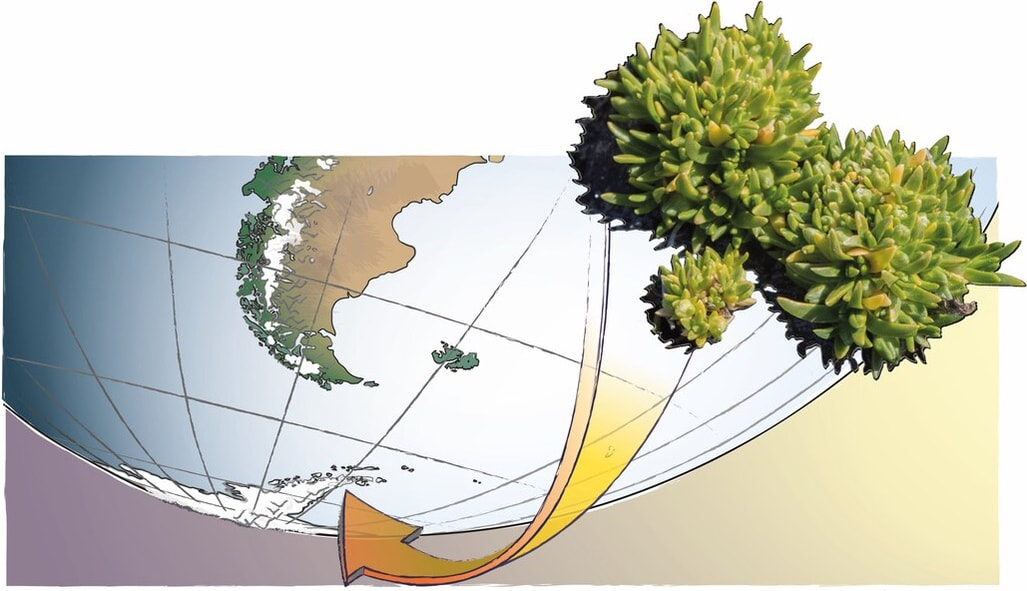|
Antarctica's isolated and extreme terrestrial environments are inhabited by only two species of native vascular flora: the Antarctic pearlwort Colobanthus quitensis (Caryophyllaceae) and the Antarctic hair grass Deschampsia antarctica (Poaceae). While many other groups of terrestrial biota (e.g. mites, springtails, mosses) include species with a long-term (million-year) survival and high endemism in Antarctica, the age and origin of both vascular plants was until now not yet thoroughly studied. A new paper in Journal of Biogeography on the Antarctic pearlwort C. quitensis (shown in Fig. 1), completing previous biogeographic assessments of the Antarctic hair grass, shows that the vascular flora of Antarctica is of likely late-Pleistocene origin. The vascular flora is hereby the first identified group of terrestrial organisms to be completely of recent arrival, with a likely origin after major glacial periods in Antartica.
The overall findings of multiple colonisation events by a vascular plant species to Antarctica, and the recent timing of these events, are of also significance with respect to future colonisations of the Antarctic by vascular plants, particularly with predicted increases in ice-free land in the Antarctic Peninsula. The results also suggest the Antarctic is less isolated for this species than previously thought.  Fig. 3. Genotype and haplotype networks of Colobanthus quitensis based on nuclear (a) and chloroplast (b, e, f) markers, and nuclear and chloroplast regions combined (c). Map (d) showing sample locations of the two Maritime Antarctic haplotype groups identified in (c) (indicated in with dashed ellipses). Colours of different biogeographic regions are shown in the key. Late-Pleistocene origin of vascular flora - a contrasting pattern to many other terrestrial biota During the Last Glacial Maximum, as well as during previous glaciation periods, almost the entire continent of Antarctica is thought to have been covered by ice. The general assumption has therefore long been that basically no terrestrial life could have persisted in Antarctica throughout this time, and all life must be of recent (post-glacial) origin. Recent biological research has challenged this view, revealing many examples of species with long-term pre-glacial persistence, suggesting that life must have persisted throughout previous glaciation periods in the Antarctic. Evidence can be found in almost every group of terrestrial organisms (e.g. nematode worms, diatoms, springtails, insects, mosses etc), with timespans of isolation in Antarctica ranging from hundreds of thousands to millions of years. Some groups even show ages of isolation since the break-up of ‘Gondwana’, where Antarctica broke off from the other Southern Hemisphere continents. Antarctica only continent with a recent (thousand year-scale) vascular flora In the new study on the cushion plant Colobanthus quitensis we find that the Antarctic populations of the species likely derived from two independent, late-Pleistocene dispersal events. Adding to previous inferences on the other Antarctic vascular plant species (a grass called Deschampsia antarctica), we suggest that both vascular plant species are likely to have arrived on a recent (late-Pleistocene) timescale. Contrary to the other groups of terrestrial biota, the vascular flora stands out as the first identified terrestrial group that appears to be entirely of recent origin.
For more information see: Biersma, E.M., Torres-Díaz, C., Molina-Montenegro, M.A., Newsham, K.K., Vidal, M.A., Collado G.A., Acuña-Rodríguez, I.S., Ballesteros, G., Figueroa, C.C., Goodall-Copestake, W.P., Leppe, M.A., Cuba-Díaz, M., Valladares, M.A., Pertierra, L.R. & Convey, P. (2020) Multiple post-glacial colonisation events of the Antarctic pearlwort Colobanthus quitensis (Caryophyllaceae) reveal the recent arrival of native Antarctic vascular flora. Journal of Biogeography
1 Comment
Congratulations for your work, it is super interesting! I am biologist, I have been working on the east side of the peninsula for many years, now I am the Expedition Leader of a sailboat carrying tourist to de west side. I have now a new history to tell to the crew! Thank you!
Reply
Leave a Reply. |
Hi! I am Elise Biersma, an evolutionary biologist studying polar plants and microbes.Archives
January 2021
Categories |




 RSS Feed
RSS Feed